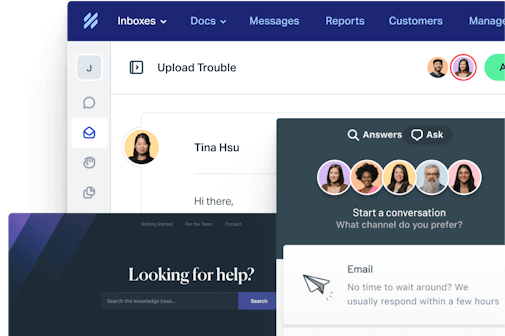When doing business online versus in person, the fundamentals remain the same while many of the specifics (and the tools) look very different.
The same goes for online customer service. It's all about taking care of your customers, and your ability to continue to adapt to the ever-changing landscape will affect how your customers experience your brand and the support you provide.
Maintaining a great customer experience does more than benefit your customers. Acquiring a new customer costs five times as much as retaining the ones you already have. Changing your strategy and following online customer service best practices can make the difference between massive churn problems or long-term success.
What is online customer service?
Online customer service is the process that companies use to answer inquiries from customers. It typically occurs in one or more channels, including:
Email
Phone
Video calls
Social media
Chat
Text
Self-service
Some more established companies may have a larger, more process-based customer service strategy, while others that are just getting started may stick to just one or two different channels.
13 online customer service best practices
From choosing the correct support channels to using online resources for self-service, and from empowering teams to keeping customer happiness a priority, understanding how to properly conduct online support is paramount to creating a fantastic customer experience.
Here are the top online customer service best practices to put in place, whether you're just starting your support team or you’re looking for some new things to keep your strategy fresh.
1. Make it easy to contact you
There is nothing more discouraging than hunting for a way to contact an online customer service team and coming up short. Make it as easy as possible for customers to contact you via the channel that makes the most sense for them.
It may be tempting to hide your contact form or phone number on a page a few clicks deep to try to steer away additional support volume. However, you may be losing customers for all of the inquiries that you turn away.
Instead, add a “Contact Us” or “Support” link to the top navigation bar on your site, making it easy to find right away. Work to ensure that search engines index your contact page, so if a customer is searching for it away from your site, it's still easily findable.
You may see a spike in conversations if you pull away your invisibility cloak, but it’s ultimately one of the best things you can do for your customers.
2. Empower your employees
Your online customer service team consists of the people in your company who know the most about your customers. While their primary job is answering inquiries and ensuring that people get help quickly, they do so much more than that.
Be sure to empower your employees to make changes to strategies and processes if they think it will be better for the customers.
While you can put systems in place to ensure that no one makes changes arbitrarily, encourage your customer service team to think about how things could be better and then propose ways to make those improvements.
Sure, you may have a whole leadership team that knows tons about business planning and metrics, but the team members on the ground will have the best insights into how to change your day-to-day work to make it more meaningful for your customers.
3. Create additional context
We all know how frustrating it is to have to repeat ourselves. When a customer comes to your support team and has to repeat the same issue they've already searched for in a knowledge base or through a search engine, it can feel like salt in the wound.
It’s especially frustrating if this is their second (or third or fourth!) conversation with your support team and they have to repeat themselves to an actual human being more than once.
Avoid this frustrating experience by creating additional internal context for your customer-facing teams. Ask your sales team members to keep notes about conversations with customers, and utilize a CRM to track customer touchpoints with your marketing, customer success, and customer support folks.
If you are using a help desk, keep track of past conversations with individual customers there, and ask your support team to read back on historical discussions with customers before starting a new one.
Taking these additional steps may feel tedious at first, but they are ultimately one of the best things you can do to ensure that your customers feel cared for.
4. Understand how you are performing
Do you know how long your customers wait for an initial reply? Or how long the average time to resolution is? How many times does a customer have to go back and forth with your team before getting their questions answered to their satisfaction?
The longer you make customers wait to hear from you, the more time you give them to start exploring your competitors' offerings. We don't have to tell you that what gets measured gets managed. Unless you're already keeping an eagle eye on your customer service metrics, chances are there are some opportunities for optimization.
Make sure your help desk comes equipped with reporting tools that are robust enough to drive the results you're looking for.
5. Never stop learning
Just because online customer support gives you more time to look things up than, say, in-person or phone support does, that doesn't mean support teams should rest on their laurels and rely solely on what the documentation says to help customers.
Forward-facing employees should know the ins and outs of how your product or service works, like any power user in the real world would. Having a solid product foundation allows you to help more customers faster and enables you to understand their experiences so you can become their advocate.
It also means that they will spend less time asking other team members for answers and will feel more empowered writing technical or complex documentation.
6. Cultivate customer centricity
Of course, you can't know the answer to every question. Even the most seasoned support pros need to collaborate with engineers and designers on more complex conversations. (That's when help desk features like notes and @mentions come in handy!) Customer support is a team sport.
One of the significant benefits of conducting most of your support online is flexibility. Empowering your entire team to talk with customers and handle their questions is critical if you want to turn your support from good to great.
Create a customer-centric culture within your company by implementing whole company support. It won't hinder folks’ long-term company-specific skills, and it will ensure that each employee sees the big picture on how to best meet customer needs.
Help everyone understand the benefits they receive by talking to customers rather than positioning it as a way to “help the support team." Every team has something that they can learn from customer conversations:
The sales team learns better positioning tactics by understanding what customers care about.
The engineering team sees firsthand how individuals are using the things that they built.
The marketing team grasps what type of content does or doesn't resonate with your users.
The product team perceives whether the features they think are valuable align with customer needs.
By ensuring everyone understands why customers are important, the support team can continue to focus on customer experience.
7. Say "thank you" and "I'm sorry"
You never need a reason to say thank you. Even if it's starting your support response off with "Thanks so much for reaching out about this," it can help to defuse a potentially tense situation.
Beyond that, if you make a mistake, don't hesitate to apologize. Yes, you're supposed to be an expert, but customers also expect you to be honest. Admitting fault and addressing an issue directly is so much more meaningful to a customer's experience than trying to push it under the rug.
Customers are more inclined to understand an issue if you have worked to cultivate a relationship with them already. A big part of building relationships is setting common ground, and using cordial and polite phrasing is one of the best ways to do that.
8. Understand what your customers want
One of the most important things to consider regarding online customer service is what your customers want and need from your support team.
Often when companies first start to offer support, they are just trying to give their customers the most basic offerings: responding to their emails, answering their phone calls, and resolving their bugs.
Once you've figured that out, it's time to start considering what your customers care about and value, rather than just trying to meet the bare minimum of what they expect.
As an example, imagine you’re a customer looking for a company to host your website. It may be important that they offer live chat since you'll want to make sure you can get an immediate response should your site go down.
In that instance, you don't want to get sent through a ticket system or to a forum. If they offer phone support, that's all well and good, but their live chat is really what matters.
Great companies like Loco2 have removed their phone number from their site and still provide the exceptional customer service they're known for because they're keenly aware of their customers' needs.
If your customers don't care about phone support but value reaching out via live chat, consider moving your resources from your phone support team over to live chat.
Beyond providing excellent service in the channels they care about, meet your customers where they are.
If they're already on your website, make sure they can find any answers they may need right from the page they're on — e.g., with an embeddable support widget like Beacon. That way, customers can discover contextual help without leaving your site.
9. Empower your customers
Self-service through a knowledge base, like Help Scout’s Docs, can be a seriously empowering benefit to your customers. When you have resources for your customers to find the answers they need right at their fingertips, you save both your customers and your team time.
However, for self-service support to be beneficial, your team needs to be strategic about it. Instead of just focusing on writing as much as you can, write the content that people are looking for most. View metrics like:
Most searched-for terms
Searches with no results returned
Most popular docs
Most viewed sites
Most common conversation tags
Docs with the lowest satisfaction ratings
Understanding how your customers are currently using your knowledge base and where they are finding dead ends when searching can give your team a target to hit when writing new content. Rather than just writing more and hoping it covers their needs, your team can start to write with metrics in mind.
10. Be more human
When you're working with customers online, via email, or through chat, the temptation can be toward a just-the-facts-ma'am style — especially if you are just getting started.
When you're creating a support team and strategy, it may be enough to simply respond to customers without putting much thought into the specific tone you use with them. After all, a pleasant style (or any particular tone, really) is more difficult to convey via text, where you don't have additional signifiers like swings in vocal pitch or friendly body language.
That said, conveying empathy via your virtual tone is a critical online customer service best practice. So, as you start to develop your strategy more fully, one of the best ways to improve your online customer support is by defining the tone of your support team.
Consider mirroring if you aren't sure what kind of definitive tone your team should be taking. Mirroring is when you match the tone your customer is using — and it lets them know you're on their side.
When a customer is formal, keep your tone strictly professional. If they're more casual, relax your tone, too — it's okay to crack a joke or include a funny GIF in your reply if the customer seems to have a sense of humor.
11. Track customer requests everywhere
Ensure that your company is tracking customer requests everywhere, especially where you aren't expecting them. Some of the best insights about how your customers feel come through channels where you don't request them.
For instance, you may find comments about your product underneath a product review written on someone else's site, on a blog post or a Youtube video, or in a Twitter conversation where commenters didn't include your company's Twitter handle.
While many companies are already tracking customer requests regularly, one of the best ways to improve your current strategy is to listen where people aren't expecting you to.
Social listening tools, like Mention, can help your customer-facing teams track what is being said about you online, both directly and indirectly.
Remember, though: It's all well and good to listen, but butting into a conversation where someone didn't explicitly mention you may rub some consumers the wrong way. Whether the insights are positive or critical, consider how it will make people feel before you respond to feedback.
12. Use negative experiences to turn things around
Did you know that if one of your users has a poor online customer service experience and your team goes above and beyond to repair the relationship, that customer will likely be more loyal to you than they'd be without having any issue at all?
Studies of the service recovery paradox show that customers with specific issues that teams have resolved well are more loyal than those without the same experience:
One of the best ways to improve your online customer service is to take the opportunity to focus on repairing the issue when things have gone awry. For instance, if you are a physical wares company experiencing shipping delays, include some small, free addition in every package.
Or, if you’re a SaaS company and you experience a downtime, you could credit customer’s accounts for the time your product wasn’t usable.
These small, relatively inexpensive things can make a big difference in your customers' overall experiences and ongoing loyalty.
13. Work toward personalization
When you're just getting started, the last thing that you're probably thinking about is personalizing your support content. Sure, you write a customer's first and last name in your support emails, but that's good enough, right? Wrong.
Personalization is one of the online customer service best practices that can significantly impact your team's overall improvement.
Start small. Behaviorally triggered in-app tools, tips, or time-based email campaigns are a great way to make customers feel like you understand them without needing to dive too deep into customer data.
Reminding customers about an abandoned shopping cart, or even just remembering what they had in their cart the next time they show up to your site through a "recently viewed items" section, can make a huge difference.
Online customer service is about listening
The best way to create an excellent online customer service strategy and continue improving it is by listening, whether it’s to your customers, to your team members, or even to cross-functional insights.
Be curious, be intuitive, and ask questions, and you will continue to improve one of the essential functions in your business.














